How to automate client onboarding: the complete guide to automated customer onboarding process
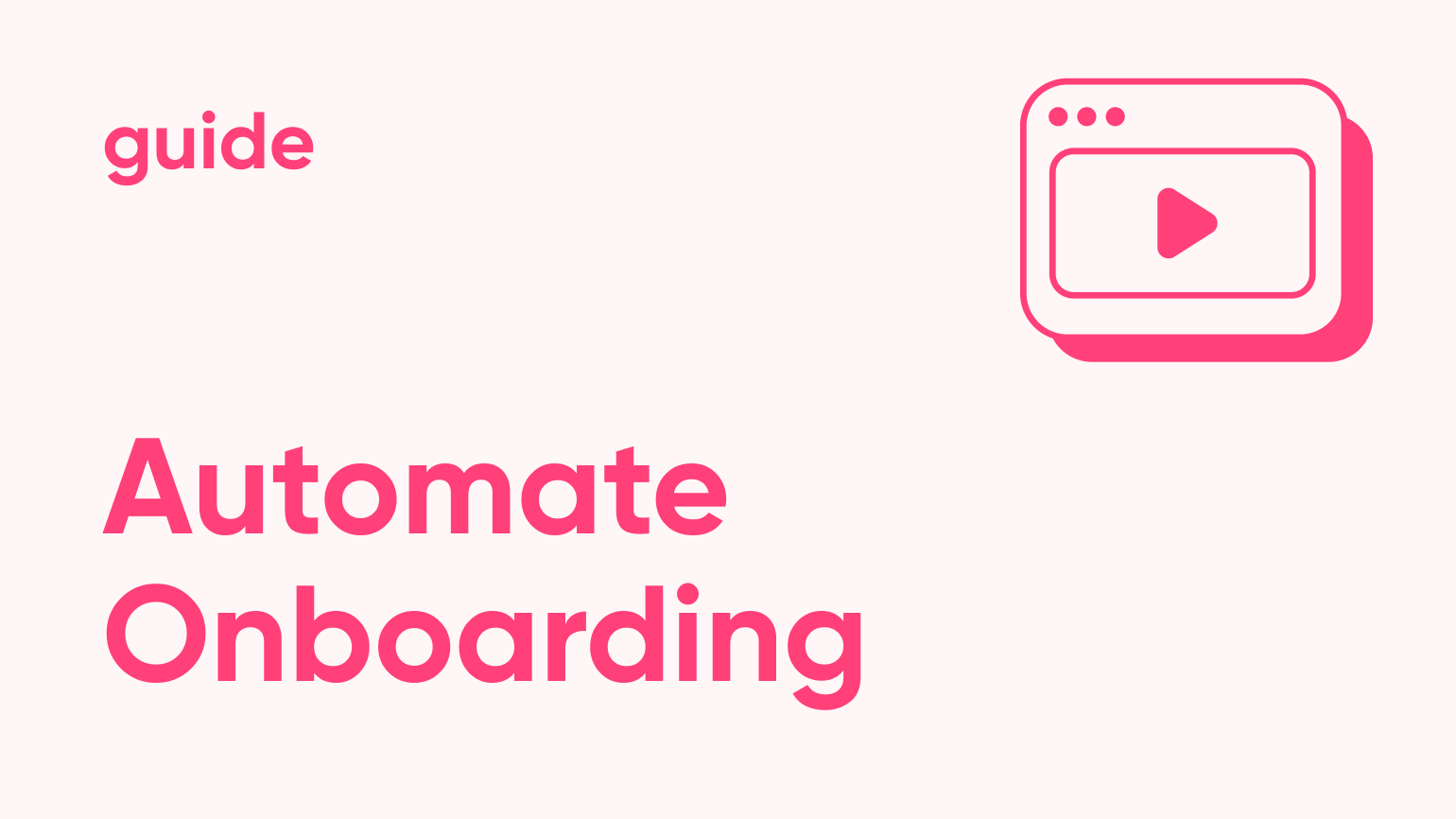
Automated customer onboarding process has evolved from a nice-to-have convenience into a business-critical competitive advantage. Take Outfunnel, a marketing automation SaaS company that revolutionized their approach in late 2023. By implementing comprehensive client onboarding automation, they saved more than 80% of their precious time while maintaining—and in many cases increasing—their customer activation rates (Outfunnel, 2023). This wasn't just efficiency gains; it was a complete transformation of how they welcomed and nurtured new customers. Their success demonstrates what happens when companies stop treating onboarding as an afterthought and start leveraging automated onboarding processes as strategic growth engines.
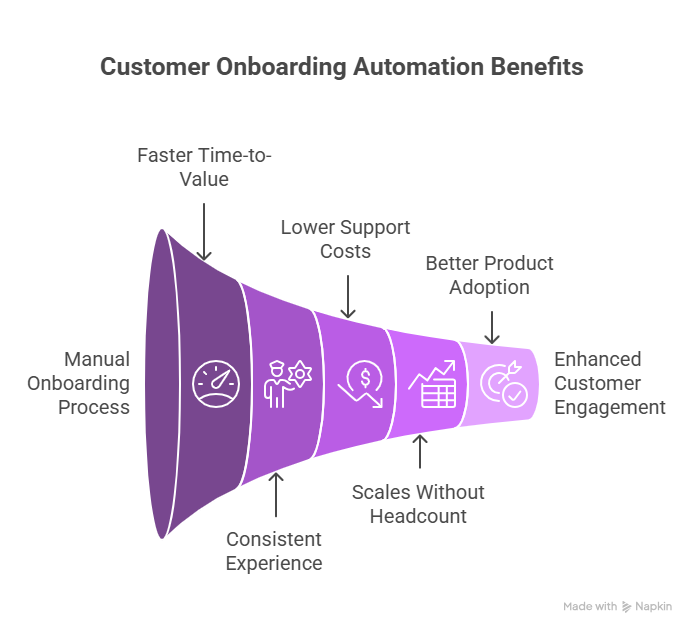
The urgency for automating onboarding has never been more pronounced. Today's customers arrive with sky-high expectations shaped by digital-first experiences across every industry. They expect immediate value, personalized guidance, and seamless interactions from day one. Meanwhile, your team faces mounting pressure to scale without proportionally increasing headcount or sacrificing quality. Research consistently shows that 86% of customers express greater loyalty to businesses that provide educational and welcoming onboarding content, while companies without structured onboarding automation face 47% higher support costs per customer. The gap between manual processes and customer expectations is widening rapidly, making automation not just beneficial but essential for survival.
What you'll discover in this comprehensive guide goes far beyond basic tool recommendations or surface-level strategies. We'll dissect the financial realities of automated client onboarding investments, from small business budgets of $10K-$25K to enterprise implementations reaching $250K, complete with hidden costs that derail unprepared projects. You'll learn how to build the right team structure and governance framework that turns automation investments into sustainable competitive advantages. We'll walk through battle-tested implementation phases, risk management strategies that prevent costly failures, and advanced techniques that create experiences customers actually love. Most importantly, you'll understand how to measure success through metrics that matter, optimize continuously, and prepare for the future of customer onboarding where artificial intelligence and predictive analytics reshape every interaction. This isn't theoretical guidance—it's practical expertise distilled from companies that have successfully transformed their customer onboarding automation into revenue-driving, loyalty-building machines.
What is customer onboarding automation?
Think of automated customer onboarding like a brilliant GPS app for new clients. Regular GPS doesn't just bark "head north and figure it out." Smart navigation guides you through every turn, warns about obstacles ahead, and adjusts the route based on your specific destination.
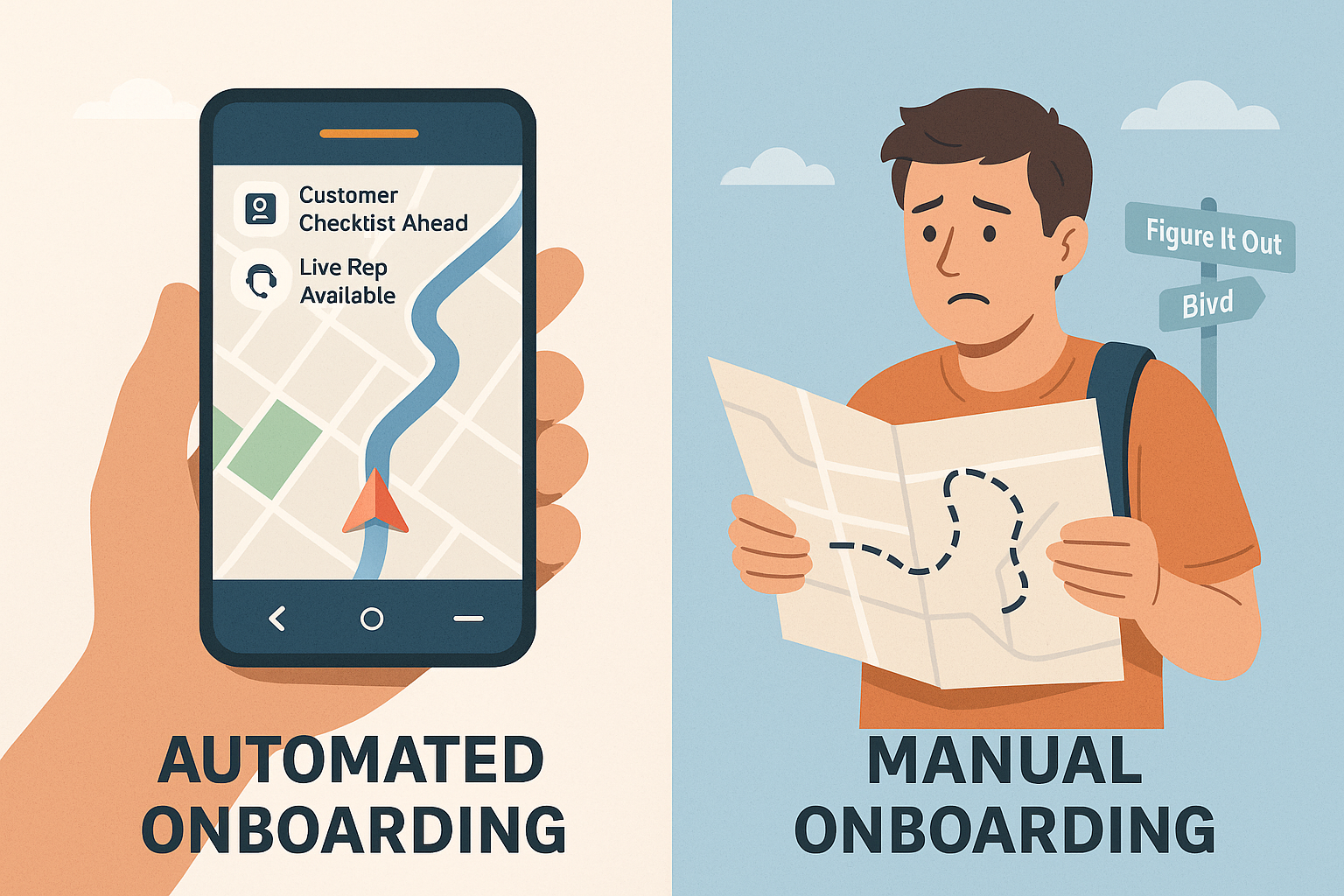
Customer onboarding automation works the same way. It uses technology and predefined workflows to guide new customers through their initial experience with your product or service. But here's where most people stumble. Process automation doesn't mean eliminating humans entirely. It's about placing human touchpoints where they create the most impact while technology handles repetitive, predictable administrative tasks.
The magic emerges when three elements align perfectly. Intelligent onboarding flow design anticipates customer needs and responds accordingly. Data-driven personalized experiences make each customer feel like their journey was crafted specifically for them. Seamless software integration creates a unified experience that flows naturally from start to finish.
Manual versus automated onboarding is like comparing a craftsman's workshop to a modern assembly line. Both can produce quality results. Only automated client onboarding scales efficiently while maintaining consistency. Manual onboarding might charm your first 50 customers. By customer 500, you'll either burn out your team or compromise the experience quality.
Volume and complexity thresholds typically kick in around 20-30 new customers monthly. The real trigger happens when your team starts repeating the same explanations, sending identical messages, or answering duplicate questions repeatedly. That's your automation moment.
Benefits of automated onboarding: why companies choose automation
Your customer success team resembles skilled chefs in a bustling restaurant kitchen. Without automation, they're headless chickens during dinner rush. Burning dishes, forgetting orders, stressed beyond belief. With automation, they become orchestrated maestros. Each team member knows exactly when to add their special touch for consistently excellent experiences.
Enhanced customer experience sits at automation's core. When customers receive timely, relevant information exactly when needed, satisfaction scores jump 23-35%. The real kicker? Consistent experience delivery becomes your competitive moat. While competitors play customer service roulette, your automated system ensures every customer gets VIP treatment.
Personalized experiences at scale become possible when automation handles heavy lifting. Your system remembers that Sarah from accounting loves detailed product tours while Mike from sales prefers quick video demos. This customization level would be impossible manually across hundreds of customers. Automation makes it feel effortless.
Operational efficiency transforms teams from firefighters to strategists. The numbers speak volumes: companies implementing comprehensive onboarding automation see $50K-$200K annual savings for mid-sized operations. The real transformation happens when teams stop spending 60% of their time on repetitive onboarding tasks. They focus on high-impact customer relationships instead.
The power to reduce manual errors becomes evident when humans stop handling routine data entry. One mistyped email or forgotten follow-up derails entire customer relationships. Automation creates bulletproof consistency that builds trust through reliability.
Scalability advantages shine brightest during growth phases. Your automated system handles 10x customer volume without proportional staff increases. Competitors scramble to hire and train new team members while you smoothly scale with existing resources. This translates directly to improved profit margins and competitive pricing flexibility.
Automation boosts team job satisfaction by eliminating soul-crushing repetitive tasks. Customer success managers focus on complex problem-solving, relationship management, and strategic account development. No more copy-pasting welcome emails or manually updating spreadsheets.
The revenue impact speaks for itself. Companies with optimized automated onboarding see 15-40% increases in customer lifetime value. Well-onboarded customers stick around longer and expand usage over time. Harvard Business Review research confirms that effective user onboarding directly correlates with improved customer retention rates.
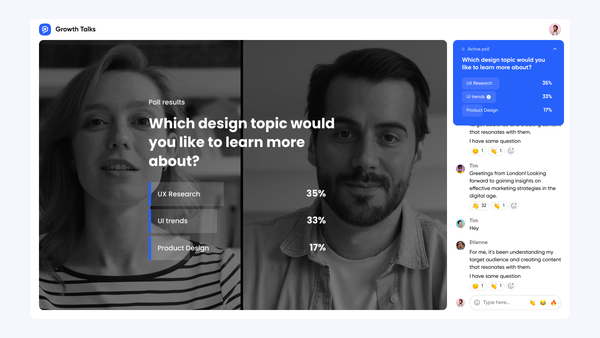
Budget and investment planning for onboarding automation
Money talk time. Your CFO probably wants this conversation first. Think automation investment like buying a premium espresso machine. The upfront cost seems steep until you calculate long-term savings versus daily coffee purchases. The ROI becomes crystal clear.
Budget planning varies dramatically based on company size and complexity needs. Small businesses (50-200 customers) typically invest $10K-$25K for comprehensive automation setup. This covers basic workflow tools, email automation platforms, and essential integrations. Mid-market companies (200-1000 customers) budget $25K-$75K for sophisticated onboarding software with advanced analytics and multi-channel capabilities.
Enterprise organizations (1000+ customers) often invest $75K-$250K for comprehensive solutions. These include custom integrations and dedicated support. But here's where projects derail: hidden costs can double your initial investment. Integration expenses surprise teams, especially connecting modern automation tools with legacy systems.
Plan 20-30% of total budget for integration work. Training and change management represent another 15-20% that teams overlook. They realize too late that their team doesn't know how to use their shiny new automation system.
Building bulletproof business cases requires focusing on tangible outcomes. Calculate current cost per onboarded customer by adding all human hours involved, then multiply by hourly rates. Most companies discover they're spending $200-$500 per customer on manual onboarding. With automation, this drops to $50-$150.
The competitive advantage argument resonates with executives who understand market dynamics. While competitors struggle with inconsistent onboarding experiences, your automated system becomes a differentiator that prospects notice during evaluation. This translates to higher close rates and reduced price sensitivity.
Total Cost of Ownership extends beyond implementation. Factor in ongoing platform fees, maintenance costs, and periodic optimization investments. Most platforms charge per user or per customer, so costs scale with growth. However, per-unit costs typically decrease as volume increases, improving margins over time.
Resource planning and team structure for automation success
Building an automation team resembles assembling a band. You need different instruments playing in harmony, not five guitarists competing for solos. The most successful automation projects combine technical skills, process expertise, and customer empathy in ways many organizations miss.
Skills gap assessment should happen before touching any automation tools. Most marketing teams have strong campaign and content skills but lack workflow design and technical integration experience. Don't worry. This is normal and fixable. The key question becomes: train existing talent or bring in specialized expertise?
Technical skills encompass integration management, workflow design, and analytics interpretation. Your team needs someone who thinks in "if-then" logic and understands how different software systems communicate. This doesn't require coding expertise, but comfort with technical concepts is essential.
The hire-versus-train decision depends on timeline and budget constraints. Training existing team members costs less upfront but extends implementation timelines by 2-3 months. Hiring specialists accelerates deployment but increases long-term personnel costs. Many successful projects use hybrid approaches: bring in consultants for initial setup and train internal team members for ongoing management.
Project governance determines success more than tool selection. Someone needs clear authority to make decisions and resolve conflicts between departments. Marketing typically drives customer experience requirements. Operations manages workflow efficiency. IT handles technical integration. Without clear leadership, these groups work at cross-purposes.
Cross-functional collaboration requires structured communication and shared accountability. Weekly standups work better than monthly status meetings because automation projects involve many moving pieces that quickly get out of sync. Shared metrics and dashboards keep everyone aligned on progress and outcomes.
Step-by-step guide: how to automate your onboarding process
Think of implementation like planning a cross-country road trip. You wouldn't jump in your car and start driving west. You'd map the route, check your vehicle, pack supplies, and plan stops along the way. Automation implementation requires the same thoughtful preparation and execution.
Phase 1: Analysis and discovery (weeks 1-3) starts with brutal honesty about your current state. Map every touchpoint in your existing onboarding journey. From contract signing moment to first meaningful outcome achievement. This isn't just documenting steps. You need to understand timing, ownership, handoffs, and failure points.
Bottleneck identification often reveals surprising insights. What feels like a customer problem might actually be an internal process issue. Customers waiting three days for account setup might not be impatient. Your manual provisioning process might be unnecessarily complex. Quick wins become obvious once you see the complete picture.
Phase 2: Design and planning (weeks 4-6) transforms analysis into actionable automation blueprints. The comprehensive onboarding checklist becomes your project roadmap. It breaks complex customer journeys into discrete, automatable tasks. Dynamic workflows branch based on customer segments, behaviors, and preferences, ensuring personalization at scale.
Data gathering points require careful consideration. You need enough information to personalize experiences without creating survey fatigue. Progressive profiling works better than lengthy initial forms. Gather essential information upfront and collect additional details over time through behavioral tracking and micro-interactions.
Phase 3: Tool selection and setup (weeks 7-9) involves evaluating platforms against specific requirements rather than feature lists. All-in-one solutions offer simplicity but might lack specialized capabilities. Best-of-breed approaches provide more flexibility but increase integration complexity. The right choice depends on your technical resources and customization needs.
Vendor evaluation should include proof-of-concept testing with your actual data and workflows. Demos look impressive, but reality testing reveals limitations and compatibility issues. Reference calls with similar companies provide insights that sales presentations can't match. Consider platforms like GuideCX and Metasource for comprehensive onboarding management.
Phase 4: Implementation and launch (weeks 10-16) requires disciplined project management and extensive testing. Phased rollouts reduce risk and enable optimization before full deployment. Start with a customer subset or simplified workflow, then gradually add complexity and volume.
Quality assurance testing should simulate real customer scenarios. Include edge cases and error conditions. Your automation system needs to handle confused customers, incomplete data, and system failures. Not just the happy path. Thorough testing prevents embarrassing failures and customer frustration.
Risk management and contingency planning
Automation projects resemble learning to ride a bicycle. You'll probably fall a few times before getting the hang of it. The difference between successful and failed implementations comes down to anticipating problems and having backup plans ready.
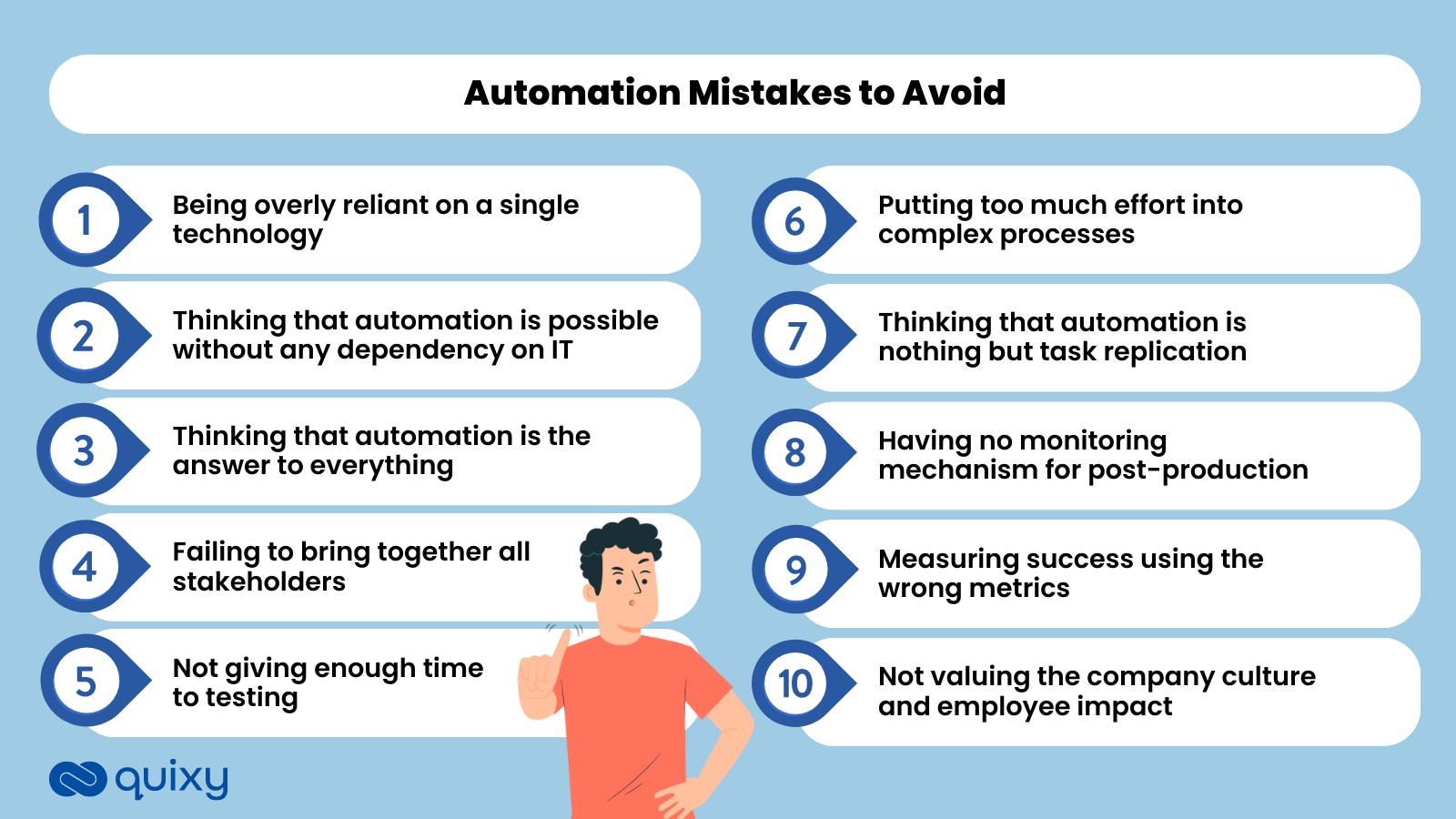
Over-automation represents the most common failure mode. Teams automate everything possible rather than everything valuable. Like GPS providing turn-by-turn directions for walking to your mailbox, excessive automation creates friction where human judgment would be more efficient. The key principle: automate routine decisions, not complex problem-solving.
Complex customer requirements and edge cases expose automation limitations. Your system might handle 80% of customers perfectly. The remaining 20% need human intervention. Design escalation pathways that feel seamless rather than like system failures. Customers should never feel like they're fighting with your automation to get help.
Technical failures are inevitable, so resilience planning is essential. System downtime, integration failures, and data corruption happen despite best efforts. Emergency manual processes keep operations running while technical issues get resolved. Document these procedures and train your team before you need them.
The hybrid automation model provides the best risk mitigation approach. Combine automated efficiency with human touchpoints at critical moments. For example, automate account setup and initial communications. Have humans handle the first strategy meeting and complex configuration decisions.
How to improve customer onboarding experience through automation
Creating exceptional automated experiences resembles being a master chef using modern kitchen equipment to enhance traditional techniques. The technology amplifies your skills and consistency. The artistry and personal touch still matter enormously.
Dynamic personalized experiences transform generic workflows into tailored journeys that make each customer feel uniquely valued. This goes beyond using their name in messages. It's about understanding their industry, role, goals, and preferences, then adapting every interaction accordingly. Your automation system should know that startup founders want fast implementation while enterprise buyers need comprehensive security verification.
Behavioral triggers create contextual relevance by responding to customer actions and engagement patterns. When someone spends time exploring your reporting features, your system should automatically deliver advanced analytics training rather than basic tutorials. This responsiveness makes automation feel intelligent rather than robotic.
Multi-channel orchestration ensures consistent experiences across email, in-app messages, video content, and human interactions. Customers shouldn't feel like they're dealing with different companies when switching between channels. Your automation system needs to maintain context and continuity regardless of how customers choose to engage.
Progress tracking and milestone celebrations tap into psychological principles that drive engagement and completion. People love seeing advancement toward goals, especially when achievements are recognized and celebrated. Your automation creates momentum by breaking complex onboarding into smaller wins and acknowledging each accomplishment.
Essential tools for onboarding automation: platform and solutions comparison
Choosing automation tools resembles building a home entertainment system. You could buy the most expensive components available. If they don't work well together, you'll have a frustrating experience instead of seamless enjoyment. Integration compatibility and workflow alignment matter more than individual feature lists.
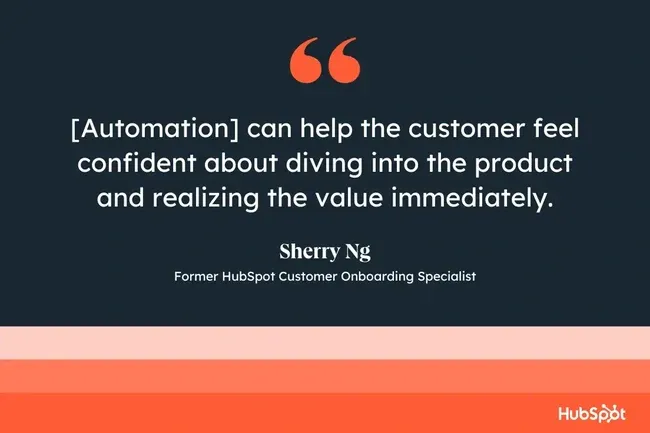
The all-in-one versus best-of-breed decision shapes your entire technology architecture. Comprehensive platforms like HubSpot or Salesforce provide integrated workflows but might lack specialized capabilities. Purpose-built tools offer advanced features but require more integration work. Most successful implementations use hybrid approaches: strong core platforms supplemented by specialized tools for specific needs.
Enterprise-grade platforms justify higher costs through scalability, security, and customization capabilities. These solutions handle complex workflow logic, large data volumes, and extensive integration requirements that would overwhelm simpler tools. However, implementation complexity and longer deployment timelines might not suit urgent projects.
Mid-market solutions balance features with budget constraints and implementation timelines. Tools like Zapier, Mailchimp, and Intercom provide robust automation capabilities without enterprise-level complexity or costs. These platforms work well for companies with straightforward workflows and limited technical resources.
API-first architecture enables future flexibility and reduces vendor lock-in risks. Tools that provide robust APIs and webhook capabilities integrate more easily with other systems. They adapt better to changing business requirements. Evaluate integration options before committing to specific platforms.
Consider RPA (Robotic Process Automation) solutions for complex data transfer and legacy system integration challenges. These tools bridge gaps between modern automation platforms and older systems that lack API capabilities.
How to streamline onboarding processes: advanced automation strategies
Advanced automation resembles conducting a symphony orchestra where every instrument knows exactly when to play, how loud, and in harmony with others. The magic happens not in individual automated tasks but in seamless coordination of multiple systems working toward common customer outcomes.
Intelligent workflow design eliminates bottlenecks by automating high-volume, repetitive tasks that don't require human judgment. This includes data entry, account provisioning, welcome communications, and progress tracking. The goal isn't removing humans entirely but freeing them for high-value activities like relationship building and complex problem-solving.
Conditional logic creates sophisticated decision trees that adapt to customer characteristics and behaviors. Your automation system should route enterprise customers through compliance-focused workflows while directing small businesses toward simplified setup processes. This branching logic makes each experience feel custom-designed rather than one-size-fits-all.
Artificial intelligence takes automation beyond rule-based workflows into predictive and adaptive experiences. Machine learning algorithms analyze customer behavior patterns, predict likely challenges, and automatically adjust workflows to improve outcomes. This creates continuously improving experiences that get better over time.
Scheduling automation eliminates back-and-forth communication for meeting coordination. Integration with calendar systems automatically books customer meetings, sends reminders, and reschedules when conflicts arise. Advanced integration techniques create unified customer experiences across multiple touchpoints.
Measuring success: KPIs and analytics for automated customer onboarding
Measuring automation success resembles being a detective investigating a really positive crime scene. You need to gather evidence, analyze patterns, and build a compelling case that proves your automation investment created meaningful business value.

Time to Value reduction represents the most critical success metric because it directly correlates with customer satisfaction and retention. Automated onboarding should dramatically reduce the time between customer signup and their first meaningful outcome with your product. Industry benchmarks suggest 50-75% TTV improvement is achievable with well-designed automation.
Customer activation rates and feature adoption metrics reveal whether automation successfully guides customers to key functionality. Your system should track not just completion of onboarding steps but engagement with core features that drive long-term value. Activated customers have significantly higher retention rates and expansion potential.
Operational efficiency metrics demonstrate automation's impact on your team and cost structure. Cost per onboarded customer should decrease substantially as manual tasks get automated. Many companies see 60-80% reduction in direct onboarding costs, creating immediate ROI and improved profit margins.
Cohort analysis reveals long-term trends and patterns that simple averages can miss. Comparing retention curves between manually onboarded and automatically onboarded customer groups provides compelling evidence of automation's business impact. Most companies see 15-25% higher customer retention rates for customers who experience automated onboarding.
ROI calculation requires tracking both cost savings and revenue impact. Direct cost savings from reduced manual labor are obvious. Automation also drives revenue growth through improved retention, faster expansion, and enhanced customer lifetime value. Comprehensive ROI analysis includes both immediate and compound benefits.
Conclusion: your automated onboarding journey starts now
We've traveled from basic automation concepts to sophisticated strategies that transform entire customer experiences. The journey from manual chaos to automated excellence isn't just about implementing new tools. It's about fundamentally reimagining how you welcome and nurture new customer relationships.
Automation is a means to an end, not an end in itself. The goal isn't removing human connection but making every human interaction more valuable, timely, and impactful. When your team stops drowning in repetitive tasks, they focus on strategic relationship building and problem-solving that actually drives business growth.
Companies that thrive in the next decade will master the balance between technological efficiency and human empathy. Your automated onboarding system should feel like having a brilliant, attentive concierge who remembers every preference and anticipates every need. Not like talking to a robot that only follows scripts.
Start small, measure everything, and iterate relentlessly. Your first automation attempt doesn't need perfection. It just needs to be better than what you're doing now. Each improvement creates momentum for the next. Before you know it, you'll have built a customer onboarding experience that becomes a competitive advantage rather than a necessary evil.
Your customers are waiting for an experience that matches their expectations of modern, digital-first interactions. The technology exists, the strategies are proven, and the ROI is measurable. The only thing left is taking the first step toward transforming your customer onboarding from a necessary challenge into your secret competitive weapon.

